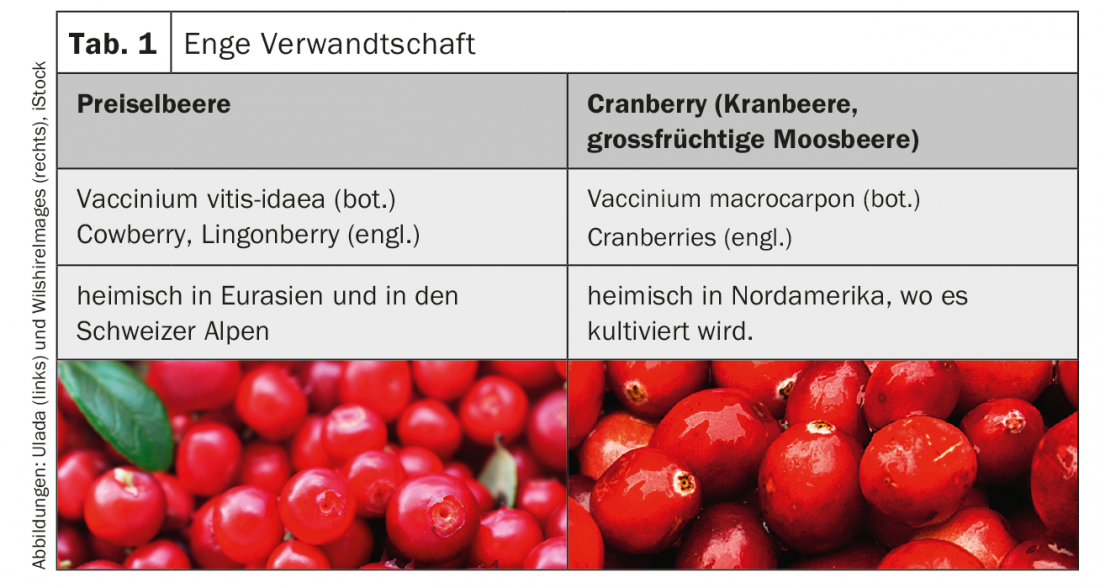A cranberry preparation as an additional treatment for cystitis: this is often recommended in doctors’ offices and pharmacies. But few experts know that in Europe most of these preparations do not contain cranberries but cranberries, and that cranberry is not the English word for cranberry.
Both medicinal plants belong to the genus Vaccinium (blueberries) of the heather family (Ericaceae), to which the bilberry also belongs. European cranberry is less common because it is less scientifically studied. Cranberry and cranberry can be easily distinguished by their size. Cranberries are about the size of grapes, while cranberries are similar in size to peas (Table 1).

What’s in it?
In both species of the genus Vaccinium, the highest concentration of very similar ingredients is found, especially in the berries. First and foremost are A-type proanthocyanidins, which belong to the flavonoids. Type A proanthocyanidins represent a mixture of oligomers consisting predominantly of epicatechin units (isomers of catechin). In addition, anthocyanins and organic acids such as benzoic acid and ascorbic acid, vitamins, tannins and minerals are found in both medicinal plants.
Effect and application
Due to the largely identical ingredients, the applications and effects are also comparable. Preparations from the fruit are used for prevention and treatment of recurrent urinary tract infections. The two medicinal plants possess anti-adhesive, antimicrobial, anti-inflammatory and antioxidant properties. The A-type proanthocyanidins are mainly responsible for this. They inhibit the attachment of bacteria to the cells of the urinary bladder. Clinical studies with cranberries showed efficacy at 30-300 ml of pure juice per day.
Studies
In a study, the daily intake of 50 ml of a Finnish combination preparation (cranberry + lingonberry) led to a reduction of urinary tract infection recurrences by about 20% after six months compared to Lactobacillus preparations or placebo. No difference was observed after twelve months [1]. Another clinical study showed that cranberry preparations were as effective as antibiotics in preventing urinary tract infections in both healthy children and children with present urogenital abnormalities [2]. The renowned Cochrane Collaboration has also looked into the effectiveness of cranberry. In a report, she notes “that cranberry juice appears to reduce the incidence of recurrence in women with recurrent UTIs during a 12-month surveillance period.” Nevertheless, the overall assessment holds that cranberry juice cannot be recommended for the reduction of UTI [3]. On the other hand, a meta-analysis declared that the efficacy of cranberry juice for prophylaxis of UTI was given [4]. No clinical studies could be found about the effectiveness of cranberries, there are only some pharmacological studies.
Summary
Cranberries and cranberries are closely related botanically and have a nearly identical spectrum of constituents that confer efficacy on both medicinal plants for the treatment and prevention of UTIs and the prevention of recurrences, respectively. In this regard, both preparations can be used. However, actual clinical studies are only available for cranberries, where there are also negative studies. The problem probably lies in the fact that for the (American) studies simply “cranberryjuice” was used, the corresponding preparation was thus quantitatively not standardized.
| Preparations in Switzerland There are several cranberry and some cranberry preparations available in Switzerland. However, they are not approved as medicines, but are registered as dietary supplements. Therefore, they are on the negative list, i.e. they may not be reimbursed by health insurance companies. |
Literature:
- Kontiokari T, et al: BMJ 2001; 322: 1571.
- Durham SA, et al: Ann Pharmacother 2015; 49(12): 1349-1356.
- Jepson RG, et al: Cranberries for preventing urinary tract infections. Cochrane Database Syst Rev 2012; 10: CD001321.
- Micali S, et al: Cranberry and recurrent cystitis: more than marketing? Crit Rev Food Sci Nutr 2014; 54(8): 1063-1075.
HAUSARZT PRAXIS 2019; 14(4): 4











